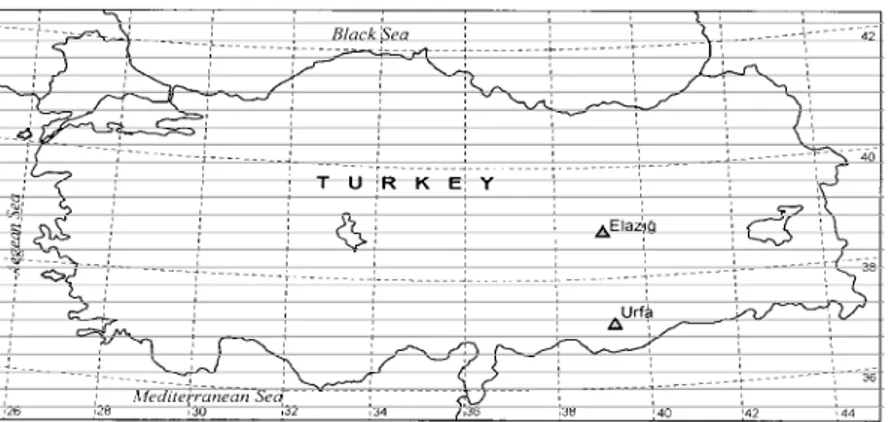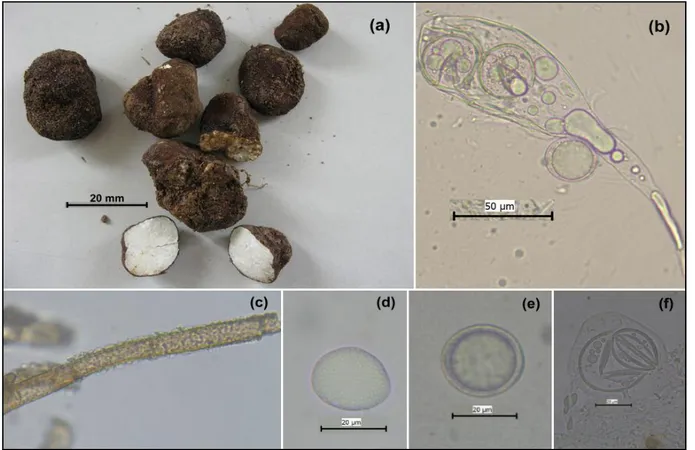www.biodicon.com Biological Diversity and Conservation ISSN 1308-8084 Online; ISSN 1308-5301 Print 3/3 (2010) 23-25
Picoa Vittad., a new truffle genus record for Turkey
Fahrettin GÜCİN 1, Abdullah KAYA *2, Mustafa Kemal SOYLU 3, Yusuf UZUN 4
1
Fatih University, Science and Arts Faculty, Department of Biology, 34500 İstanbul, Turkey
2
Karamanoğlu Mehmetbey University, Kâmil Özdağ Science Faculty, Department of Biology, 70100 Karaman, Turkey 3 Atatürk Central Horticultural Research Institute, Department of Mushroom Science, 77102 Yalova, Turkey
4
Yüzüncü Yıl University, Science and Arts Faculty, Department of Biology, 65080 Van, Turkey
Abstract
The genus Picoa Vittad. is recorded from Turkey for the first time, by determining the Picoa lefebvrei (Pat.) Maire. Short description of the taxon is provided together with the photograps of fruit bodies and microstructures. Key words: Ascomycota, Biodiversity, Macrofungi, New record.
--- ∗ ---
Picoa Vittad., Türkiye için yeni bir domalan cins kaydı Özet
Picoa Vittad. cinsi, P. lefebvrei (Pat.) Maire.’nin tanımlanmasıyla Türkiye’den ilk kez kaydedildi. Türün makroskobisi ve mikroskobisine ait fotograflarla birlikte kısa tanımlaması verildi.
Anahtar Kelimeler: Ascomycota, Biyoçeşitlilik, Makromantarlar, Yeni kayıt 1. Introduction
Picoa Vittad. is a mycorrhizal hypogeus ascomycete truffle genus with four confirmed species (Picoa juniperi Vittad., P. lefebvrei (Pat.) Maire, P. melospora G. Moreno and P. pachyascus M. Lange) (www.speciesfungorum.org; accessed 15 March 2010). Picoa lefebvrei, main interest of this work, was first proposed by Patouillard (1894) as Phaeangium lefebrvrei, by describing the sample with a smooth, villose, brown surface; a milk-white, homogenous gleba; and ovoid, smooth, hyaline spores. Disputing the Patouillard’s description related to sporocarp surface and gleba structure, Maire (1906) synonymized the Phaeangium lefebvrei to Picoa lefebvrei on the basis of his observations (Alsheikh and Trappe, 1983). Though Alsheikh and Trappe, like Fisher, Masseee and Bataille, continued to recognize the genus Phaeangium (Alsheikh and Trappe, 1983), we follow the Maire’s conclusion, in accordance with the most recent literature (Moreno et al., 2000; Kirk et al., 2008).
The genus Picoa is known to ocur in Tunisia (Patouillard, 1984), Kuwait, Algeria, Libya, Iraq (Alsheikh and Trappe, 1983), North America (Fellner and Biber, 1989), Egypt (Pacioni and El-Kholy, 1994), France (Riousset et al, 1989), Spain (Moreno et al, 2000), Iran (Ammarellou and Trappe, 2007) and Israel (Kagan-Zur and Roth-Bejerano, 2008). According to the current checklists (Solak et al., 2007; Sesli and Denchev, 2008) Picoa lefebvrei has not previously been recorded from Turkey.
The study aims to contribute to macromycota of Turkey by adding a new generic record.
*
Corresponding author / Haberleşmeden sorumlu yazar: Tel.: +903382262115; E-mail: kayaabd@hotmail.com
24 Biological Diversity and Conservation – 3 / 3 (2010)
2. Materials and methods
Picoa samples were collected from Elazığ and Urfa provinces (Fig. 1). Following standard mycological techniques, necessary macroscopic and microscopic data were obtained and the samples were identified with the help of Alsheikh and Trappe (1983) and Moreno et al. (2000). Microphotographs were taken by Leica DFC 290 through a light microscope Leica CME. The specimens are kept in the fungarium of Fatih University, Faculty of Art & Science, Department of Biology. 3. Results Ascomycota Pezizomycetes Pezizomycetidae Pezizales Incertae sedis
Picoa lefebvrei (Pat.) Maire (1906).
Synonym: Phaeangium lefebvrei Patouillard, (1894) Terfezia schweinfurthii Hennings, (1901)
Macroscopic features: Ascocarp hypogeous, gregarious 7-25×7-27 mm, subglobose to irregular, brown, reddish-brown to dark brown, coverd with a reddish-brown, with more or less irregular pyramidal rounded warty mycelial tomentum. Gleba evenly white when young, white to paler white with fertile pockets separated by pale off-white veins when mature (Fig. 2a). Odour strong, pleasant.
Microscopic features: Ascospores 22-27×20-25 μm, broadly ellipsoid to globose, hyaline with a large lipid guttule, thin and smooth walled when young, the wall become 2-3 μm and covered by uniform, scattered or crowded, hyaline warts at maturity (Fig. 2d,e,f). Asci 90-140×40-65 μm, 2-8 spored, ellipsoid to club-shaped, with a pedicel (Fig. 2b). Peridial tomental hyphae 8-12 μm, cylindrical, septate, yellow to pale brown, with hyaline to light brown surface granules (Fig. 2c). Peridium 180–300 μm thick. Ectal excipulum up to 200 μm thick, composed of globose to subpolygonal cells, brownish-yellow. Ental excipulum up to100 μm thick, composed of cylindrical, hyaline, interwoven hyphae.
Specimens examined: Elazığ, Baskil, Harabakayış village, hillside, 38°28′ N – 38°45′ E, 1200 m, 22.04.1984, F Gücin: 284517; Kadıköy village, arid hillside, 38°26′ N – 38°43′ E, 1100 m, 08.05.1984, F Gücin: 284521. Şanlıurfa, Bozova, Küçük Tümlen village, arid hillside, 37°18′ N – 38°38′ E,, 729 m, M.K.Soylu: 69.
Figure 1. Collection sites of Picoa lefebvrei 4. Conclusions and discussion
Hypogeous fungi are those fungi which produce macroscopic fruit-bodies partially or completely embedded in soil. Although they show a superficial similarity correlated with habitat, they include members of the Basidiomycetes, Ascomycetes and Phycomycetes (Hawker, 2008).
According to latest contributions (Akata et al., 2009; Kaya, 2009; Sesli et al., 2009; Doğan and Aktaş, 2010) and the current checklists (Solak et al., 2007; Sesli and Denchev, 2010) six hypogeus Ascomycete truffle taxa have so far been recorded from Turkey. Two of them (Terfezia arenaria (Moris) Trappe, T. boudieri Chatin belong to the genus Terfezia (Tul. & C. Tul.) Tul. & C. Tul., one (Tirmania pinoyi (Maire) Malençon) to Tirmania Chatin and three (Tuber aestivum Vittad., T. brumale Vittad. and T. borchii Vittad.) to Tuber Vittad. With the addition of P. lefebvrei the number of Turkish Ascomycete truffle taxa increased to seven.
P. lefebvrei is seldom known in the regions where collected and named as “kara kumi” in Urfa. It usually shares the similar habitats with T. boudieri which is heavily collected and consumed especially in Urfa province.
Fahrettin GÜCİN et al., Picoa Vittad., a new truffle genus record for Turkey
Biological Diversity and Conservation – 3 / 3 (2010) 25
Figure 2. Picoa lefebvrei. a. Ascocarps, b. Ascus, c. Tomental hypha, d-e. Ascospores, f. Collapsed ascospores.
References
Akata, I., Doğan, H.H., Çetin, B., Işıloğlu, M. 2009. Onnia tomentosa (Fr.) P. Karst, a new genus record for Turkey. Biological Diversity and Conservation. 2/1: 78-81.
Alsheikh, A.M., Trappe, J.M. 1983. Taxonomy of Phaeangium lefebvrei, a desert truffle eaten by birds. Canadian Journal of Botany. 61: 1919-1925.
Ammarellou, A., Trappe, J.M. 2007. A First Ascomycete Genus (Picoa sp.) record for the fungi flora of Iran. Pakistan Journal of Biological Sciences. 10/10: 1772.
Doğan, H.H., Aktaş, S. 2010. Two new Ascomycetes records from Mediterranean part of Turkey. Biological Diversity and Conservation. 3/1: 83-86.
Fellner, R., Biber, J. 1989. Helianthemum and some Agaricales: Unusual case of ectomycorrhizal symbiosis. Agriculture Ecosystem and Environment. 28: 121-125.
Hawker, L.E., 2008. Hypogeous Fungi, Biological Reviews 30: 127-158.
Kagan-Zur, V., Roth-Bejerano, N. 2008. Studying the brown desert truffles of Israel. Israel Journal of Plant Sciences. 56: 309–314.
Kaya, A. 2009. Macromycetes of Kahramanmaraş Province (Turkey). Mycotaxon. 108: 31-34.
Kirk, P.F., Cannon, P.F., Minter, D.W., Stalpers, J.A. 2008. Dictionary of the fungi, 10 th ed., CAB International, Wallingford.
Maire, R. 1906. Notes mycologiques. Annales Mycologici. 4: 329-335.
Moreno, G., Diez, J., Manjon, J.L. 2000. Picoa lefebvrei and Tirmania nivea, two rare hypogeous fungi from Spain. Mycological Research. 104: 378-381.
Pacioni, G., El-Kholy, H. 1994. Turtufi del deseerto egiziano. Micologia e Vegetazione Metiterranea. 9: 69-84. Patouillard, N. 1894. Les terfez de la Tunisie. Journal de Botanique (Morot). 8: 153-156.
Riousset, L., Riousset, G., Jalade, M., Chevalier, G. 1989. Prima raccolta in Francia di Phaeangium lefebvrei Patouillard 1894. Il Fungo, 9–11.
Sesli, E., Antonin, V., Denchev, C.M, 2009. A new record of Chrysomphalina chrysophylla (Basidiomycota, Hygrophoraceae) for Turkey. Biological Diversity and Conservation. 2/3: 156-158.
Sesli, E., Denchev, C.M, 2010. Checklists of the myxomycetes, larger ascomycetes, and larger basidiomycetes in Turkey. Mycotaxon. 106 [2008]: 65-68 + on-line version: 1-133 (http://www.mycotaxon.com/ resources/checklists/seslisesliv106-checklist.pdf).
Solak, M.H., Isıloglu, M., Kalmıs, E., Allı, H. 2007. Macrofungi of Turkey. Checklist, Volume I Üniversiteliler Ofset, Bornova-Izmir.

